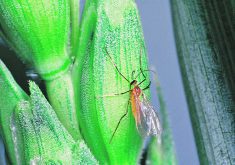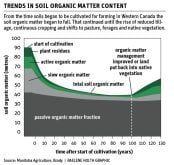There are more living organisms in one handful of healthy soil than there are humans on Earth. Their impact on soil fertility may soon change soil testing forever.
Soil testing already plays an important role in nutrient management decisions. Standard soil tests reveal levels of particular forms of macro and micro nutrients, pH, salinity and soil organic matter.
However, conventional methods stop short of measuring the biology of soil and the influence that soil micro-organisms have on nutrient availability and soil fertility.
Soil is home to many thousands of living organisms. Burrowing animals and insects such as gophers, earthworms, ants, and mites are the easiest to see, but they make up only a small portion of the life found in the soil.
Read Also

Growing garlic by the thousands in Manitoba
Grower holds a planting party day every fall as a crowd gathers to help put 28,000 plants, and sometimes more, into theground
These large organisms play a role in creating biopores that increase aeration and water infiltration while naturally turning over the soil.
Australia’s primary industries department estimated that healthy soil earthworms can renew topsoil at an average rate of five millimetres a year.
As important as these large organisms are, the real powerhouses of soil are seen only under a microscope.
Nematodes, protozoa, bacteria and fungi are plentiful in the soil. These microbes affect the nutrient availability for plants both directly by interacting with the plants and indirectly by breaking down rocks and organic matter and freeing up nutrients in the process.
Microbes interact directly with plants to provide nutrients.
Glomeromycota fungi make up one of the seven divisions in the fungi kingdom and are known for the way they build up mutually beneficial relationships with plant roots.
These fungi form associations with 70 percent of all land plants and act like an extension of the plant root to increase the reach of the roots.
The glomeromycota have hyphae that are smaller than root hairs. These hyphae access nutrients in soil micro-pores that a root would be too large to access on its own. The fungi provide phosphorus to plants in exchange for food in the form of sugars, fats and amino acids.
Symbiosis is another type of plant-fungi interaction. Instead of extending the reach of a plant, fungi take up residence inside the plant.
Symbiosis is seen in root nodules of legumes, where fungi give nitrogen to the plant in exchange for a home and a supply of carbon-containing food.
This type of relationship is also seen in forage grasses such as tall fescue and perennial ryegrass, where the fungus inhabits all areas of the forages and dramatically improves plant growth.
Even without direct crop interaction, soil microbes can make nutrients available by breaking down rocks and parent material so nutrients that had been locked away become available for plants.
Microbes secrete acids that digest minerals and weather rocks to release nutrients such as phosphorus and potassium.
Nutrients are also made available when microbes break down crop residue, manure and other organic matter. It can take microbes anywhere from a few months to a few thousand years to break down the organic matter completely, depending on the type of matter that is present.
Simple compounds such as sugars and fats can be consumed by microbes in a matter of weeks, while stable compounds such as lignin found in humus can remain unchanged for hundreds and even thousands of years.
Microbes scavenge organic matter to harvest the sugars, fats, amino acids and other carbon forms, which they use as food. Then they exhale or excrete other nutrients from the organic matter in plant available forms.
It may soon become normal for soil tests to consider soil microbe populations and their activity.
Future tests may indicate whether nutrients come from commercial fertilizer or from natural microbes interacting with crops, thus dissolving parent material or breaking down crop residues.
When combined with standard soil tests, this information will allow growers to improve their nutrient application efficiency by revealing both the nutrients available in the soil and the nutrients that will become available by microbes throughout the growing season.
An example of this is the Haney suite of tests, developed by Richard Haney at the U.S. Department of Agriculture.
The tests measure soil health by mimicking the soil environment and the effect microbes have on nutrient availability.
Soil in the test goes through wetting, drying and the addition of an acid similar to what microbes release to acquire nutrients. In some cases, the tests have reduced nitrogen fertilizer costs by $15 per acre.
As it becomes available to growers, more calibration is required to determine how accurately it reflects the state of nutrients in the soil.
A University of Colorado study examined the usefulness of measuring soil microbial communities along with standard soil tests compared to standard soil tests alone. It found that under some conditions, the statistical usefulness of soil testing increased when it factored in the microbes.
Considering the profound effect soil microbes have on making nutrients available to plants, it’s likely that future soil tests will include an analysis of soil biology alongside current soil chemistry data.
Amy Unger is a guest columnist for Agronomy Precisely. You can reach her at amyu@mymts.net.

















